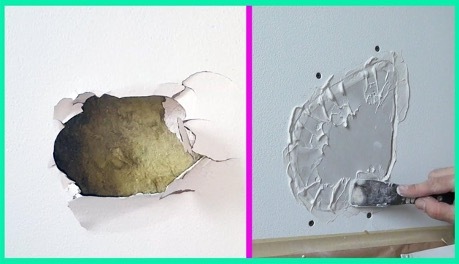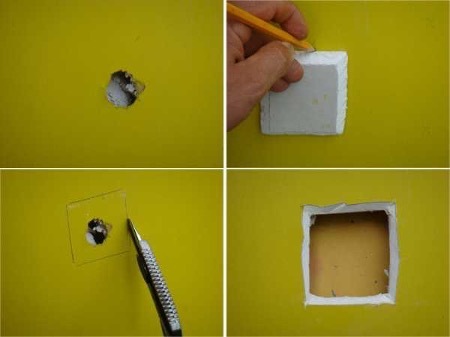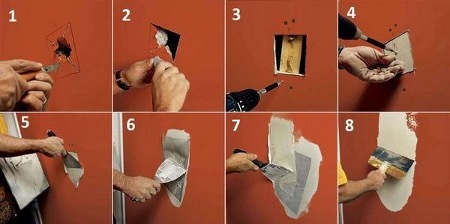
Walls finished with plasterboard look neat and modern, but sometimes holes may appear on their surface from impacts, perforations, or other damage. In such cases, the question arises of how to repair a hole in the drywall on the wall in order to restore the original appearance of the room. In this material we will analyze the main stages and methods of solving this problem.
The content of the article
- Where can such a problem come from?
- Damage assessment and selection of tools
- Technology for sealing small and medium holes
- Working with large holes
- Final stage: painting and finishing
Where can such a problem come from?
Holes in plasterboard walls can appear for various reasons, depending on operating conditions and the nature of the damage. Let's look at the most common situations in which holes can form in drywall:
- Mechanical damage is the most common cause of holes. Impacts from furniture, appliances, or other hard objects can easily penetrate drywall, especially if the impact was forceful or sharp-edged.
- During the installation of plasterboard sheets or the subsequent installation of shelves, pictures and other decorative elements, holes may be created. This can happen due to using the wrong tool or incorrect technique.
- Drywall is sensitive to moisture, and if water gets on the wall, it can cause softening and subsequent formation of holes.
- Over time, drywall can lose its strength, which leads to the appearance of cracks and holes, especially in areas subject to increased mechanical stress.
- If the drywall was installed incorrectly or the fastenings were not strong, this could lead to holes in the future.
- Temperature fluctuations can cause materials to expand and contract, which in turn can cause cracks and holes in drywall.
- Some pests, such as mice or termites, can chew holes in drywall walls, creating unpleasant surprises for homeowners.
Each of these situations requires an individual approach to restoring the surface of a plasterboard wall, and understanding the causes of the damage will help you choose the right repair method.
Damage assessment and selection of tools

The first step to restoring the surface of a drywall wall is assessing the damage. The size and nature of the defect will determine how to repair the hole in the drywall and what tools and materials will be needed for the job. Small holes can be repaired more easily and quickly than larger ones and require less materials.
The next step is choosing the necessary tools. The basic set of tools you will need to complete the job:
- Spatula for applying and leveling putty.
- A drywall hacksaw or a regular construction knife to correct the shape of the hole.
- Sanding paper or sanding block for finishing the surface.
- Level for checking the horizontal and vertical surface.
After choosing the tools, you should select the necessary materials. How to repair a hole in drywall is a question whose answer depends on the size of the damage and your personal preference. Putty, plasterboard plates, painting mesh or reinforcing tape, as well as fasteners - this is the main list of materials for repairing plasterboard walls.
Finally, before you begin, make sure you have enough time and space to complete all steps of sealing the hole properly. Take your time, follow the instructions and ensure proper attention to each step to ensure a long-lasting and aesthetically pleasing result.
Technology for sealing small and medium holes
How to repair a hole in drywall is a question that has several answers. For small and medium-sized holes, regular putty or special drywall mixtures are ideal.
- First, sand the edges of the hole to remove any rough edges.
- If the hole is small, simply apply putty with a putty knife, filling the hole.
- For medium holes, use painter's mesh or reinforcement tape to create a base for the putty.
- Apply putty, level the surface and let dry.
- After the putty has dried, sand the surface until smooth.
Working with large holes

When it comes to large holes, there is a need to create a more reliable base for the putty.
- To start, how to cut a hole in drywall to make it a more regular shape: use a drywall hacksaw or a regular construction knife.
- Prepare a piece of drywall of the required size that will be inserted into the hole.
- Attach reinforcement tape or masking mesh for better hold.
- Apply putty, level the surface and let dry.
- Sand and, if necessary, repeat the filling and sanding process.
Final stage: painting and finishing
Once the hole in the drywall is completely sealed and the wall surface is smooth, you can begin painting. This is the last step that will give your wall its original appearance and hide the traces of repair work.
Choosing the right materials and carefully performing all stages of the work will help to efficiently and reliably seal holes in the drywall, returning the walls to an attractive appearance.


